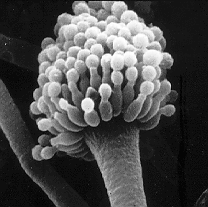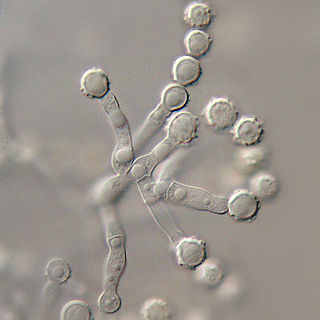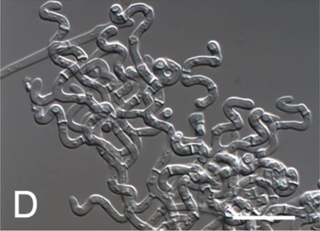
Eurotiomycetes is a large class of ascomycetes with cleistothecial ascocarps within the subphylum Pezizomycotina, currently containing around 3810 species according to the Catalogue of Life. It is the third largest lichenized class, with more than 1200 lichen species that are mostly bitunicate in the formation of asci. It contains most of the fungi previously known morphologically as "Plectomycetes".

The Eurotiales are an order of sac fungi, also known as the green and blue molds. It was circumscribed in 1980.

The Hypocreales are an order of fungi within the class Sordariomycetes. In 2008, it was estimated that it contained some 237 genera, and 2647 species in seven families. Since then, a considerable number of further taxa have been identified, including an additional family, the Stachybotryaceae. Wijayawardene et al. in 2020 added more families and genera to the order. According to the Catalog of Life, As of April 2021 the Hypocreales contains 6 families, 137 genera, and 1411 species. Hyde et al. (2020a) listed 14 families under Hypocreales, while, Wijayawardene et al. (2022) accepted 15 families in the order, where Cylindriaceae was additionally added. Earlier, Hyde et al. (2020a) had placed Cylindriaceae in class Xylariomycetidae. Samarakoon et al. (2022) agreed. Hence, Cylindriaceae should have been excluded from Hypocreales and placed in Xylariomycetidae. Xiao et al. (2022) recently introduced a new family Polycephalomycetaceae to Hypocreales.

The Hypocreaceae are a family within the class Sordariomycetes. Species are recognisable by their brightly coloured perithecial ascomata, typically yellow, orange or red. The family was proposed by Giuseppe De Notaris in 1844. According to the Dictionary of the Fungi, the family has 22 genera and 454 species. In 2020, it was re-analysed and determined to have only 17 genera and about 658 species.

The order Sordariales is one of the most diverse taxonomic groups within the Sordariomycetes.
Chrysosporium is a genus of hyaline hyphomycetes fungi in the family Onygenaceae.
The Pleomassariaceae are a family of fungi in the order Pleosporales. Taxa have a widespread distribution in both temperate and tropical regions, and are saprobic or necrotrophic on wood, bark, and other herbaceous material. The genus was circumscribed by mycologist Margaret Elizabeth Barr-Bigelow in 1979.

The Microascaceae are a family of fungi in the class Sordariomycetes, subclass Hypocreomycetidae. The family was published by David Malloch in 1970, an emended description based on Everet Stanley Luttrell's original 1951 publication. Family was updated in 2020.
Montagnula is a genus of fungi in the family Didymosphaeriaceae. The genus, circumscribed by mycologist Augusto Napoleone Berlese in 1896, contains an estimated 24 species in 2008, but is probably polyphyletic as currently circumscribed. It was originally placed in family Montagnulaceae, before that family was dissolved and it was later placed in family Didymosphaeriaceae, with 34 species.

The Coniochaetales are an order of fungi within the class Sordariomycetes. This order was monotypic and contained a single family, the Coniochaetaceae, historically placed in the order Sordariales. However, this taxonomic placement has been challenged by other authorities, and the Coniochaetales was proposed to include the family Coniochaetaceae. In 2020, family Cordanaceae was added to the order.
Monosporascus is a genus of fungi in the family Diatrypaceae. It has nine species. The type species, Monosporascus cannonballus, is a widespread plant pathogen that causes vine decline of melon and watermelon crops.
Ascotaiwania is a genus of fungi in the Sordariomycetes class of the Ascomycota. In 2020, it was placed in the order Savoryellales and family of Savoryellaceae.
Jugulospora is a genus of fungi that was placed within the Lasiosphaeriaceae family, It was then moved into the Neoschizotheciaceae family. This was thought to be a monotypic genus, containing the single species Jugulospora rotula, until more species were found.

The Onygenaceae are a family of fungi in the Ascomycota, class Eurotiomycetes.

Arachnomyces is a genus of cleistothecial ascomycete fungi described in 1902, of which the anamorph (asexual) stage is the genus Onychocola. Although morphologically similar to members of other families, the fungus now belongs to its own monotypic family Arachnomycetaceae, which is the only family in the monotypic order Arachnomycetales.

The Apiosporaceae are a family of fungi in the Ascomycota. It was placed in the order Amphisphaeriales in 2020.
Sphaerodes is a genus of fungi within the Coronophorales order but it has not been placed within a family.
Scopinella is a genus of fungi in the Coronophorales order. The relationship of this taxon to other taxa within the order was unknown, It has been placed into the family of Ceratostomataceae.

The Nitschkiaceae are a family of fungi in the Ascomycota, order Coronophorales. Species in the family are mostly saprobic on wood, although some grow on lichens.
Oidiodendron is a genus of fungi in the family Myxotrichaceae. It has 26 species. The genus was circumscribed by Norwegian forester Håkon Robak in 1932, with Oidiodendron fuscum assigned as the type species. The species is now known as Oidiodendron tenuissimum.










